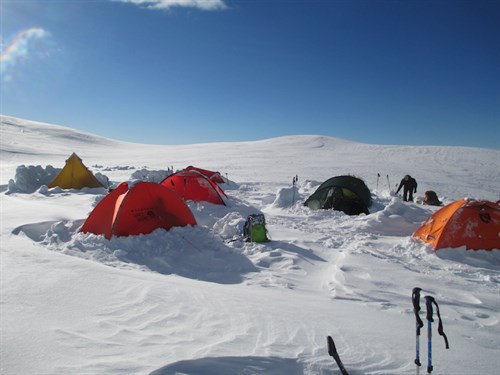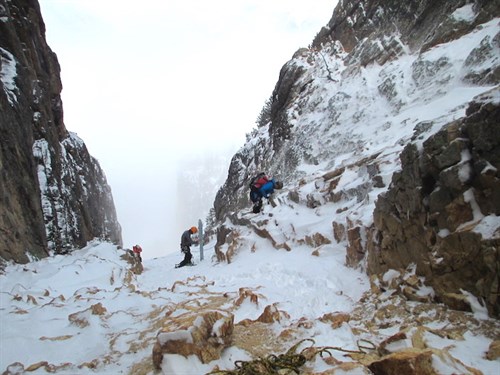What's the Best Month to Climb in the Cascades?
Seasonal Differences in AAI Summer Mountaineering Programs
We are often asked, "What's the best time to climb Mt. Baker … or Mt. Shuksan, or the Liberty Bell?” The answer is that there's really no bad time, but there are definite differences in the prevailing weather and conditions throughout the summer climbing season. These differences can affect the experience you have and what skills are emphasized in our different programs that tackle these peaks.
If you are interested in a guided climb up a specific technical route or objective, contact our office for details, as certain routes may have a narrower window during which a climb is likely to be successful.
If you are interested in standard glacier routes on Mt. Baker or Mt. Shuksan (or one of the other major cascade peaks); or in one of our core instructional programs (Alpinism 1 or Alpinism 2, courses in the Alpine Mountaineering and Technical Leadership (AMTL) series, the Glacier Skills and Crevasse Rescue course, the Alpine Ice course, etc), then here are some things to consider as you are trying to decide when to join us for a climb or program.
Early Season (late April - mid/late May): The Big Mountain Experience
Most of the Cascades mountaineering programs at the American Alpine Institute start around the end of April or beginning of May. These late spring/early summer sessions tend to have more soft snow left-over from the winter. Sometimes we'll even get a big dump of snow on that first course of the season.

Early season camp at about 6,000 ft. on Mt. Baker, Washington. A snow-block windbreak can be seen on the left.
With so much soft snow around, this can sometimes add extra walking along the road to get to the normal trailheads, and may necessitate the use of snowshoes. Climbers may need more and/or heavier insulating layers to keep warm. The soft snow can make it challenging to practice good crampon technique, though we will cover the fundamentals in all sessions.
One of the upsides to this time of the year is that many large crevasses are still covered by winter snowpack, so this can make for easier navigation and route finding on the glaciers – assuming the weather is clear.
Best of all, these early-season programs are great training for those who have ambitions of climbing in the colder, harsher environments we see on high-altitude expeditions like Denali and the Seven Summits. Early season trips give aspiring high-altitude climbers an opportunity to put themselves and their gear to the test in a supervised scenario with the guidance of an experienced instructor.
Transitional Period (late May - mid/late June): Something for Everyone … And Be Ready for Anything
As we approach the summer solstice, the weather becomes more variable. It can go from clear skies and sunshine to 36 degrees and raining sideways - sometimes even on the same day! This demands that the climbers be ready for any condition. However, the road access begins to get easier - it can be surprising how fast the snow on a forest road can melt in a couple of days during this time of year. The glaciers are also still relatively filled in, which can make for more efficient route finding and travel. This is a great time to learn skills if you have plans for your own climbing objectives later in the summer.
Alpine rock climbing is mostly on dry rock, but may still have snowy approaches depending on how heavy the preceding winter was, and that snow can sometimes make the approaches more straightforward and easier.
Mid Season (late June – early/mid August): Great Weather, But at What Price?
July and August usually have the longest, most consistent stretches of good weather. For locals, this time of the year makes the wet, gray winters worth it. That doesn't mean it never rains – there are occasional storms that still roll through. However, there is less variability in the weather and the forecasts become more reliable.
With the consistent warm weather often comes rapid melting. It can be astonishing how fast the glaciers can change during this time of the year. It can also cause large fluctuations in creek levels, so well-timed crossings become more important. The glacier snow is more consolidated, which can make for good cramponing. There is also usually a sweet-spot in here where there is good enough access to steeper alpine ice climbs, but things aren't so melted out that the routes go out of climbable condition.
That all being said, the unfortunate truth about this part of the summer that we have to deal with more and more every year is the threat of wildfires and smoke. There can be a massive spectrum in how this can affect a trip. Some years the fires are small and remote and there is barely a whiff of smoke in the air. Other years the fires aren't even in Washington, but we get smoke from Canada, Idaho, or Oregon. And in some unfortunate years, we've had to change climbing venues due to the impending threat of a rapidly spreading fire. Luckily, AAI has never had to cancel or postpone a program due to smoke or fire in the Cascades as we have been able to shift the itinerary or location.
Late Summer (mid August - late September): Dry rock, dry glaciers
The tail end of summer usually has good stretches of nice weather for climbing. This is one of the most popular times of year for all types of outdoor enthusiasts in Washington. The days are still long and there is plenty of daylight for those long objectives. As you get closer to the end of September, some variability can creep in and there can be a mix of rain occasionally, but rain-free days are often warm and sunny. This portion of the season still has wildfire risk until the autumn rains are more consistent. With long dry periods leading up to this time of year, it can also make access to water in the alpine difficult, which could translate into needing to carry more water with you to camp or on climbs. There are occasionally some exceptionally hot periods from late July to late August (high 80’s - low 100’s in the lowlands), but if it does get that hot it usually only lasts for a week or so.
The other factor that can be challenging for the late season is the condition of the glaciers. After spending long days baking in the sun, all of the snow has consolidated down into hard glacier ice. With no soft snow, it is challenging to discuss avalanches. But it’s easy to develop higher-end cramponing skills. Indeed, as there’s more ice, more and more time is spent on this as it is essential for both individual and team safety.
In the latter part of the season, crevasses on the glacier are more numerous, with some of them growing to be very large. This can sometimes make route finding through the crevasse fields more time-consuming. While rare, it is not unheard of to have specific routes on Mt. Baker, Mt. Rainier, and other classic Cascade peaks close down for the season due to impassible crevasses. The Alpine Institute often sends out additional instructors and guides to summit-oriented programs in this time of the year in order to help manage these challenging conditions.
The Off-Season: Is There Such a Thing?
In truth, the summer "climbing season" is an artificial idea build around the relative predictability of good weather. Many people love to climb in short weather windows throughout the fall. In particular, ice-climbers seek out cold, clear spells to tackle water-ice routes that form for brief periods.
In the winter, of course, the hills are a playground for skiers, and many mountaineers combine both activities to hit backcountry stashes and steep couloirs. Avalanche hazard increases once the snow begins to fall, and backcountry travelers need to gain knowledge and skills to manage the risks.

An advanced AAI team doing an early season ascent of the Beckey Route, Liberty Bell, in Washington Pass. The climb will be followed by a ski descent of the couloir.
Winter mountaineering, while not nearly as popular as summer mountaineering, has a dedicated following. The cold, snowy conditions appeal to some people's taste for hardship and the challenge of adaptation. The development of these skills is the specific focus of AAI's Denali Prep course.
As spring arrives, the snowpack begins to stabilize for the season and ski mountaineers seek out lines that were too dangerous during the winter months. The freeze-thaw cycle begins to reach the higher summits, producing a firm base with spring corn snow on the surface. This is an excellent season for training in mixed climbing and for summit climbs with ski descents.
And the summer returns.
How do I choose?
With so many variables to account for, it might be difficult to know which session is right for you.
In the end, the most important thing is that it fits into your schedule. If you have limited availability, then that will be the deciding factor and we recommend that you book early to accommodate your schedule. The core curriculums of the longer instructional courses (Alpinism 1 and 2, AMTL courses) are uniform for the entire season, and while it may be more practical and efficient to emphasize certain skills during particular times of the year, all of the core skills will be covered regardless of when you take your program.
If you have more open availability, then start looking at the different options and think about what your future climbing goals are. How do those goals align with the different conditions in the different phases of the summer sessions? Which is going to be the best learning environment for those future goals?
If you are someone who intends to take multiple courses over the coming years, strategically take courses in different periods of the season. This will allow you to develop skills and confidence in a variety of different mountain conditions.
As noted here, there are both rewards and challenges in each of the different periods. And regardless of which one you choose, we know you’ll have a great time developing your skills with us in the mountains. And we look forward to getting out there with you!
Click here to see a list of all our Cascades climbing and skiing/riding programs.
If you have additional questions, please reach out to a Program Coordinator at [email protected] or by calling 360-671-1505.
Program Finder